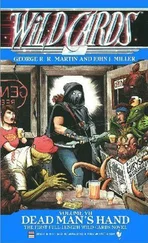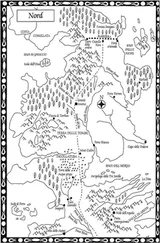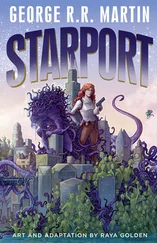Old Mars
An anthology of stories edited by Gardner Dozois and George R R Martin
Introduction RED PLANET BLUES
BY GEORGE R. R. MARTIN
ONCE UPON A TIME THERE WAS A PLANET CALLED MARS, A world of red sands, canals, and endless adventure. I remember it well, for I went there often as a child.
Born and raised in Bayonne, New Jersey, I came from a blue-collar, working-class background. My family never had much money. We lived in a federal housing project, never owned a car, never went much of anywhere. The projects were on First Street, my school was on Fifth Street, a straight shot up Lord Avenue, and for most of my childhood those five blocks were my world.
It never mattered, though, for I had other worlds. A voracious reader, first of comic books (superheroes, mostly, but some Classics Illustrated and Disney stuff as well), then of paperbacks (science fiction, horror, and fantasy, with a seasoning of murder mysteries, adventure yarns, and historicals), I traveled far and wide while hunched down in my favorite chair, turning pages.
I soared among the skyscrapers of Metropolis with Superman, fought bad guys in Gotham City with Batman, swung between the water towers of Manhattan with Spider-Man. I sailed the South Seas with Long John Silver and Robert Louis Stevenson, and swam beneath them with Aquaman and Prince Namor the Submariner. Scrooge McDuck took me to Darkest Africa to search for King Solomon’s Mines, and H. Rider Haggard returned me there. I swashed and buckled and fought the Cardinal’s men with the Three Musketeers and Dumas Père, sang of the Green Hills of Earth with the blind singer Rhysling and Robert A. Heinlein, trekked across Big Planet with Jack Vance, sped through the Caves of Steel with Isaac Asimov, and dared the terrors of the Mines of Moria with J. R. R. Tolkien. Books became my passport to Arrakis and Trantor, Minas Tirith and Gormenghast, Oz and Shangri-La, all the lands of myth and fable …
… and to the planets, moons, and asteroids of our solar system as well. Frozen Pluto (still a planet!), where the sun was just a bright star in the sky. Titan, with Saturn and its rings looming overhead. Mercury, one face turned eternally toward the sun, where life could only survive in the “twilight zone” between day and night. Mighty Jupiter, whose fearsome gravity made its inhabitants stronger than a hundred men. Venus, hidden beneath its shroud of cloud, where web-footed natives (Venusians or Venerians, take your pick) hunted dinosaurs through fetid, steaming swamps.
And Mars.
Growing up, I think I went to Mars more often than I went to New York City, though Manhattan was only forty-five minutes and fifteen cents away by bus. We usually made a Christmas trip to New York, saw the holiday show at Radio City Music Hall, ate in the Horn & Hardart automat in Times Square. That was pretty much all I knew of New York City (yes, I knew of the Empire State Building and the Statue of Liberty, but never visited either one until the seventies, long after I had moved away from New Jersey).
Mars, though … I knew Mars inside and out. A desert planet, dry and cold and red (of course), it had seen a thousand civilizations rise and fall. The Martians that remained were a dwindling race, old and wise and mysterious, sometimes malignant, sometimes benevolent, always unknowable. Mars was a land of strange and savage beasts (thoats! Tharks! sandmice!), whispering winds, towering mountains, vast seas of red sand crisscrossed by dry canals, and crumbling porcelain cities where mystery and adventure lurked around every corner.
Mars has always had a certain fascination for us Earthlings. It was one of the original planets, the Fab Five of antiquity (along with Mercury, Venus, Jupiter, and Saturn), the “wanderers” who refused to march in step with the stars, but made their own way through the heavens. And Mars was red , its color visible even to the naked eyes of the ancients; the color of blood and fire. Small wonder the Romans named it after their god of war. Galileo’s observations of Mars through his telescope, Cassini’s revelation of the polar ice caps in 1666, and Asaph Hall’s discovery of the Martian moons Phobos and Deimos in 1877 only served to make the red planet even more appealing … but it was Italian astronomer Giovanni Schiaparelli’s announcement that he had observed “canali” on Mars that cinched the deal.
The name Schiaparelli gave the dark lines he saw on the Martian surface actually means “channels,” but when reported in English it was rendered as “canals.” Channels can be natural; canals are artificial. And 1877 was part of an era when man-made canals were very much in the public consciousness. The Erie Canal, completed in 1825, had played a key role in the westward expansion of America. The Suez Canal had opened in 1869, connecting the Mediterranean to the Indian Ocean. The French would begin work on the Panama Canal just a few years later, in 1881; the Americans would finish it in 1914.
Each had been a massive undertaking, a wonder of modern engineering, and if there were canals on Mars … well, surely there must be canal builders as well. Surely there must be Martians .
Small wonder then that when Herbert George Wells sat down a few years later to write a “scientific romance” of alien invasion called The War of the Worlds , he looked to the red planet for his invaders. “Across the gulf of space,” Wells wrote, “minds that are to our minds as ours are to those of the beasts that perish, intellects vast and cool and unsympathetic, regarded this earth with envious eyes, and slowly and surely drew their plans against us.”
Schiaparelli’s observations had awakened the interest of scientists as well as novelists. In particular, they had excited the interest of the American astronomer Percival Lowell. Lowell’s new observatory in Flagstaff, Arizona, boasted larger telescopes than Schiaparelli’s in Milan, and had less light pollution to contend with as well. Powell trained those telescopes on Mars … and saw, not “channels,” but canals .
Mars became Lowell’s passion. For the rest of his life he studied the red planet extensively, finding more every time he looked, drawing extensive, intricate, and detailed maps of the Martian surface, complete with canals, double canals, oases. He published his findings and theories in three enormously popular and influential books: Mars (1896), Mars and Its Canals (1906), and Mars as the Abode of Life (1908), promulgating the theory that the canals, long and straight and obviously artificial, had been built by a Martian race to carry water from the polar ice caps to the vast deserts of their arid planet.
Other astronomers turned their telescopes on Mars as well. Some of them saw Lowell’s canals, confirming his findings at least in part. Others saw only Schiaparelli’s channels, and put them down as natural features. Some saw nothing at all and insisted all these canals were optical illusions. By and large, the astronomical community remained skeptical of Lowell and his observations … but the idea of Martian canals, and the Martian civilization it suggested, had taken firm root in the public consciousness.
Especially in the minds of the storytellers.
H. G. Wells had given the world Martians, but he himself never took us to Mars. That task he left to a (much lesser) writer named Garrett P. Serviss, who published a sort of sequel to War of the Worlds called Edison’s Conquest of Mars in 1898. Though largely (and deservedly) forgotten today, the Serviss novel was widely read and influential in its day, and was the first to carry the reader across the gulf of space to the red planet, with its two moons, windswept deserts, and Schiaparellian canals. But it was a later writer who truly brought that landscape to life, and established the template that would inspire generations of science-fiction writers to come, and thrill and delight thousands upon thousands of readers like myself.
Читать дальше












